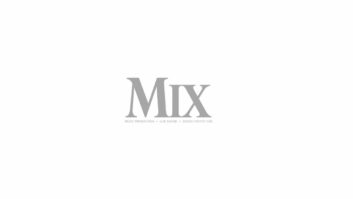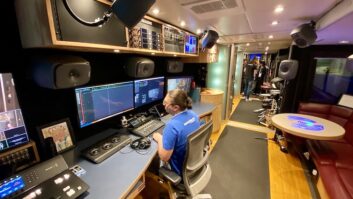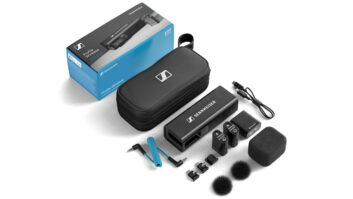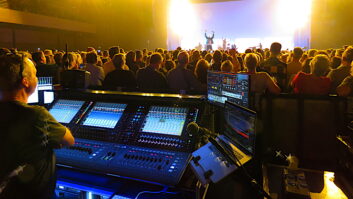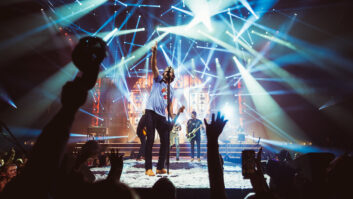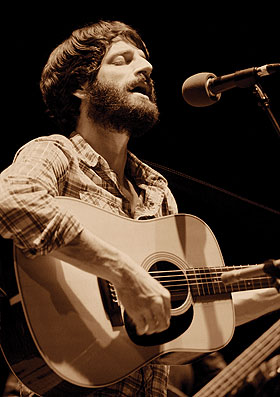
Pictured here from a concert in 2007, Ray LaMontagne has retained his oneness with his guitar.
Photo: Steve Jennings
It’s the voice that first hits you. A mixture of yearning and heartbreak, delivered in a raspy, delicate fashion that bypasses the ears and punches deep within. You realize that the music is very well written, a perfect backing track for that sad, aching voice.

System tech Mike Savage (left) and front-of-house engineer Doug Dawson
Photo: Candace Horgan
After a late start, Ray LaMontagne has garnered a very successful career, with his songs covered by many artists. Backed by his band, the Pariah Dogs (drummer Jay Bellerose, bassist Jennifer Condos, and guitarists Eric Heywood and Greg Leisz), the live performances are low on flash and chatter with the audience. In fact, in June 2011 at Red Rocks (Morrison, Colo.), LaMontagne may not have spoken more than 10 sentences to the sold-out crowd during the course of two hours. LaMontagne sets himself up on stage-left, with Condos standing to his right, Bellerose in the middle and the guitarists on stage-right. The band performs in a semicircle so they can see each other playing and cue off of each other. “I hate to say it, but you could turn the band off, and as long as you can hear his voice nice and loud, they’re going to cry,” says front-of-house engineer Doug Dawson.
Dawson and monitor engineer Dean Norman have been with LaMontagne since 2007, but the two have a working relationship that stretches back 17 years. Norman was working FOH for Emmylou Harris, and when Buddy Miller joined Harris, he brought in Dawson, who he had worked with in Jim Lauderdale’s band, to handle monitors. “Whoever gets the gig first gets front of house and then talks the other one in to do monitors,” says Norman with a laugh. “Doug and I have toured together for 16, 17 years with five, six, seven bands. We’ve worked together a lot, and always try to get the other one in if one of us gets a gig.”
Dawson first came on with LaMontagne for a temporary two-week stint, but Dawson’s talents at mixing vocals led to a more full-time job. “I got on when the tour manager called me up one day and asked me to fill in for two weeks,” he says. “I flew out and it was a lot of these guys’ first show. By the end of the two weeks, Ray was having a hard time onstage with sounds, and they offered me the job, then hired Dean and we fixed a lot stuff with his acoustic guitar sounds to make him more at ease in theaters, which we had a lot experience in. I do a lot of theater work with bands who aren’t familiar with halls and volume. He was having a hard time because it’s a loud band and you have to turn it down.”
Despite his predilection for analog, Dawson is mixing on an Avid Profile board and finds he does like the console’s ease of use. “I use Crane Song Phoenix plug-ins, which I love. I’m really an analog guy,” Dawson says. “I think digital is easy. If I could, I’d carry the biggest, most analog-y system I could find, but it’s really for the ease. I also use a Crane Song head—which is a harmonically enhanced device—on the left and right, and it gives me a sort of tube flavor. It’s digital, but it makes it sound big; I can’t stand thin. People comment on how fat my mixes are. I can’t stand it when it’s shrill; it has to be big and fat.
“Ray sings so delicately—it’s a very delicate mix, very vocal-oriented—so I have a few good preamps on the main instruments and that makes a huge difference,” Dawson continues. “I have some preamps that I use that are D.I.Y.; they are kits you buy from Seventh Circle Audio in L.A., and they sound fantastic. I have about eight mics that are spread out through the band and Ray’s vocal that I have the preamps on; they are very pristine-sounding.’

Monitor engineer Dean Norman at the Avid Profile
Photo: Candace Horgan
Dawson keeps the effects to a minimum, employing an outboard TC Electronic M5000 double-loaded reverb unit with two preset reverbs that he uses on Lamontagne’s guitar and vocals. He also uses the Waves C4 multiband compressor plug-in on the desk. He mixes in stereo, putting Lamontagne straight up the middle and splitting the guitars to either side.
“I can’t stand the reverbs that are in the desk; it does not compute,” Dawson says with a laugh. “I’m pretty unconventional when it comes to mixing; I’m not doing anything crazy. I don’t use gates. I don’t clamp then down; if they want to go kaboom, it goes kaboom. That’s their business. I’m not trying to tailor a mix; I’m making what they do louder. As a matter of fact, I’m not a gearhead. I just like sound, so I do whatever it takes to get a nice, comfortable sound that’s really pretty, something that’s beautiful, not constructed.”
At Red Rocks, Dawson was flying a Meyer MILO rig with 700-HP subs, with 16 cabinets a side. Near-fills were eight M’elodie cabinets onstage. The rig is powered with Galileos: one for the MILOs, and one for the subs and the M’elodies. “I love the horns on Meyer,” says Dawson. “I’ve used every speaker out there, but none of them sound vocally as nice as the Meyers to me.”
To help control the bass, the subs are arranged in a cardioid fashion, with everything delayed and phase-reversed. LaMontagne doesn’t like to hear too much bass onstage because he feels it distorts and gets in the way of what he’s trying to do, and if he does, he gets “flustered,” according to Dawson. Helping to come up with a way to work it is system tech Mike Savage.
“We go for a quarter wavelength, centered at 63 Hz,” says Savage. “The mid-center two are phase-reversed and delayed so that everything is lined up nicely, and it cancels at the back. You get a nice, really tight bass sound, even everywhere, and it works great.”
As for tuning, “We don’t rely on pink noise and Smaart to EQ the P.A.,” says Dawson. “We listen by ear and make sure things are in phase. The music I choose to play, no one in their right mind would use. We use gospel, a cappella singers and Nick Lowe, vocal stuff to listen to. The drums and guitar and stuff with this band are so good, so you aren’t doing a lot to it, and if you did do a lot to it, you’d be screwing it up badly. There are a lot of engineers that want to manhandle it, and this isn’t that. It’s all finesse.”
Like his longtime counterpart, monitor engineer Norman is using a Profile desk, which he has used for two years now. In addition to its ease of use, Norman appreciates that the desk is pretty standard; when his main console went down before a gig in Antwerp, Belgium, last year, he was able to truck in another one from across town. Effects are also kept to a minimum.
“A few standard compressors and reverbs, and a Waves C4 is about the only plug-in that doesn’t come on the desk,” says Norman. “It keeps things in balance, especially with the acoustic guitar, to level it out. The dynamics of this show are pretty amazing, from barely a whisper to out-and-out rock. It helps keep the guitar in check, depending on how hard he is playing. These guys prefer to find their mix, where they can hear one another and kind of mix themselves. That’s why they are in a semi-circle: They can watch one another and play off one another. The level of musicianship is just incredible, absolutely incredible. You just let these guys hear one another and they just stand around in a little circle and go.”

Wedges are L-Acoustics 15XTs for all the supporting players, but due to LaMontagne’s desire to hear more of the hall, Norman had to experiment before finding an ideal solution: a pair of M’elodie cabinets onstage placed about 10 feet away from LaMontagne and angled slightly upward. “Ray really didn’t like the immediacy of a monitor being so close to him; he felt like it was right in his face, and he wanted a little more air and more space,” says Norman. “With the M’elodies, it fills that whole side of the stage with his vocal. It kind of works like a sidefill, but because Ray is stage-left, traditional sidefills wouldn’t work. It was the only way I could figure to get him the air and the space on the guitar and the vocal. He really likes it better. The guitar just sounds so much more natural coming from a distance instead of from a wedge right at your feet blowing up at your face.”
For the mixes, Leisz and Heywood get full mixes of the band. Bellerose just gets LaMontagne and locks in with him, as does Condos. LaMontagne basically gets himself, but it can be a complicated process. “The one thing about Ray’s monitor is it’s not about a level,” says Norman. “Usually during soundcheck, I’m spending time turning his monitor down because he really likes to play off the house. He wants to hear the house coming back and just have enough wedge in there to focus on so it’s not a wash. In a place like Red Rocks, there’s no problem hearing the house coming back with those huge stone walls on either side. Other venues that are open lawn and nothing there to reflect the P.A. back, it’s tough for Ray: He wants to hear the house; he doesn’t want to play off the monitor. It’s another reason I put it 10 feet away from him so it’s more ambient, as if he were hearing the house coming back. He just has himself in there and really not a lot of that.”
For the summer tour, Norman switched out LaMontagne’s vocal microphone from a standard Neumann KMS 105 to a Shure Beta 58a because he found the Neumann was too sensitive. He expects to go back to the Neumann in the fall when the band is playing theaters again. The rest of the microphones are mostly Shures.
“We have a Beta 52a on the kick, SM57 on the snare and Beta 98s on all the toms,” says Norman. “Jay attaches lots of shakers to his left ankle, so we have a 98 mounted on the bottom of the hi-hat stand for the leg shakers. Some Sennheiser e 604s on the guitar. We have Shure KSM32s on the overheads. On the overs, we are doing an overhead and sidehead, a take on the old BBC miking method with a side mic by the floor tom equidistant from the snare overhead mic. It’s a 1942 drum kit, so you have to mike the kit; you can’t really close-mike each drum and have it sound like the kit. The bass is going through an old BSS DI, which I think sounds better, and then we are miking her 4×10 cabinet with a Beta 98, which people look at every day, and say, ‘Wow, I’ve never seen that before.’ We’ve found it really adds clarity to the bass. It’s a really round tone that she uses, so more low end is the last thing we need.”
Additionally, Norman has a pair of Audio-Technica shotgun microphones pointed at the audience, as he is multitrack recording every show for possible radio broadcasts in those towns at a later date. “I’m recording with MADI out of the Profile to an RME MADI interface into my Sony laptop, and I’ve been recording with the new [PreSonus] Studio One software,” says Norman. “I run 24/48. We don’t have a very large band, so I think total it’s 26, 27 tracks, including audience mics. I’m an old Cubase and Nuendo user, and this software is written by the guy who wrote Nuendo, from what I understand, and it’s working really well.”
Candace Horgan is a Denver-based writer.
